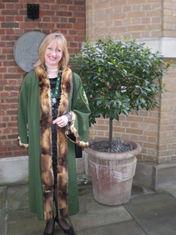
Since my last column I have had a busy month, mostly focused on our own livery. The Honorary Assistants’ dinner took place on 19 April at The Coopers’ Hall in Devonshire Square. Invited were all the current honorary assistants, those due to retire later this month and those just about to take office at the Audit Court Dinner. At any one time we have eight in office and each serves for two years.
The role of honorary assistant is a vital one in that the incumbents sit on the court of the livery and are to a large extent the ears for the court and also form the backbone of the committees that we have.
Our livery has a communications sub-committee, the function of which is to ensure the membership is kept informed about what the company is doing and to make sure we are in contact with all liverymen.
They are also involved with fundraising for our various charitable endeavours. The sale of company Christmas cards in recent years has gone from strength to strength and raised a very good donation. I know the plans are well underway for this year’s selection, so do consider buying your cards from the livery as it does make a significant difference to the charities we support.
Members of the sub-committee are also involved in communicating the Fruiterers’ activities and objectives to the outside world.
The finance sub-committee looks after our funds to plan a steady growth. We are very lucky to have some brilliant minds working to secure our ‘giving’ and to make sure that we can continue to support our causes, both charitable and fruit-centred, with research grants, scholarships and awards. The Awards Council set their minds as to how we can utilise these monies to best effect for the industry.
The dinner was a great success with lively debate and some very constructive ideas. All of those I spoke to enjoyed being on the court and felt they had learned so much more about what the company quietly achieves.
Most of the people at the dinner have offered to help at Guildhall Yard on 23 June when there is to be a ‘Celebrate the City’ market. We are looking at the event as a fundraising opportunity to boost our charitable reserves and also as a chance to raise the profile of the livery. Most links of the fruit industry supply chain will be represented from grower to retailer, and of course, we are all consumers. I look forward to seeing Fruiterers and other industry representatives at our stall.
Another point that came through at the dinner was how much the honorary assistants had gained from their experience. They have the opportunity to attend more functions, meet a wider circle of individuals and to generally get a better understanding of the workings of the company.
Later in April, 50 of us had an enjoyable day out in Old Spitalfields Market, right in the heart of the City. We met at an exceptional cheese restaurant called Androuet, which was once the stand of a vegetable wholesaler. To see the old building finding another use was very interesting and there were plenty of people who were able to provide reminiscences about their experiences when they had worked in the market or the Fruit Exchange.
Following a fine lunch, we walked around the immediate area accompanied by a very knowledgeable Blue Badge city guide. We were told something of the history of the area. This related not only to the fruit industry’s effect on Spitalfields, but the impact of some of the other trades and communities who have worked in the district, such as the silk weavers.
Then on to Dennis Severs’ House in Folgate Street. This building has been restored with each room showing a different period in history. The effect is to illustrate how the fortunes of the silk weavers changed over time.
The day was very interesting for me and I am pleased to say, judging by the many letters I have subsequently received, for many of the Fruiterers who were in the party. Many of those who used to work in the market commented that they had been employed in Spitalfields for so many years but knew nothing of the area outside their immediate environs. I tend to think also of the value of stopping, looking back at what has happened and to evaluate if everything we do now is an improvement or are there some aspects from previous history that we could learn from. -